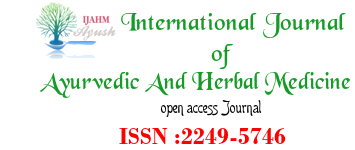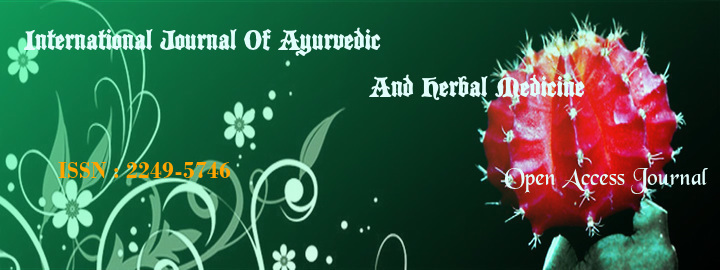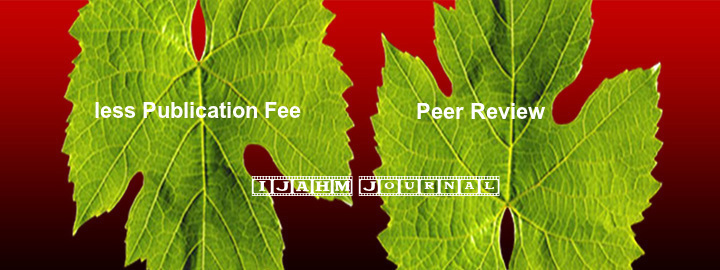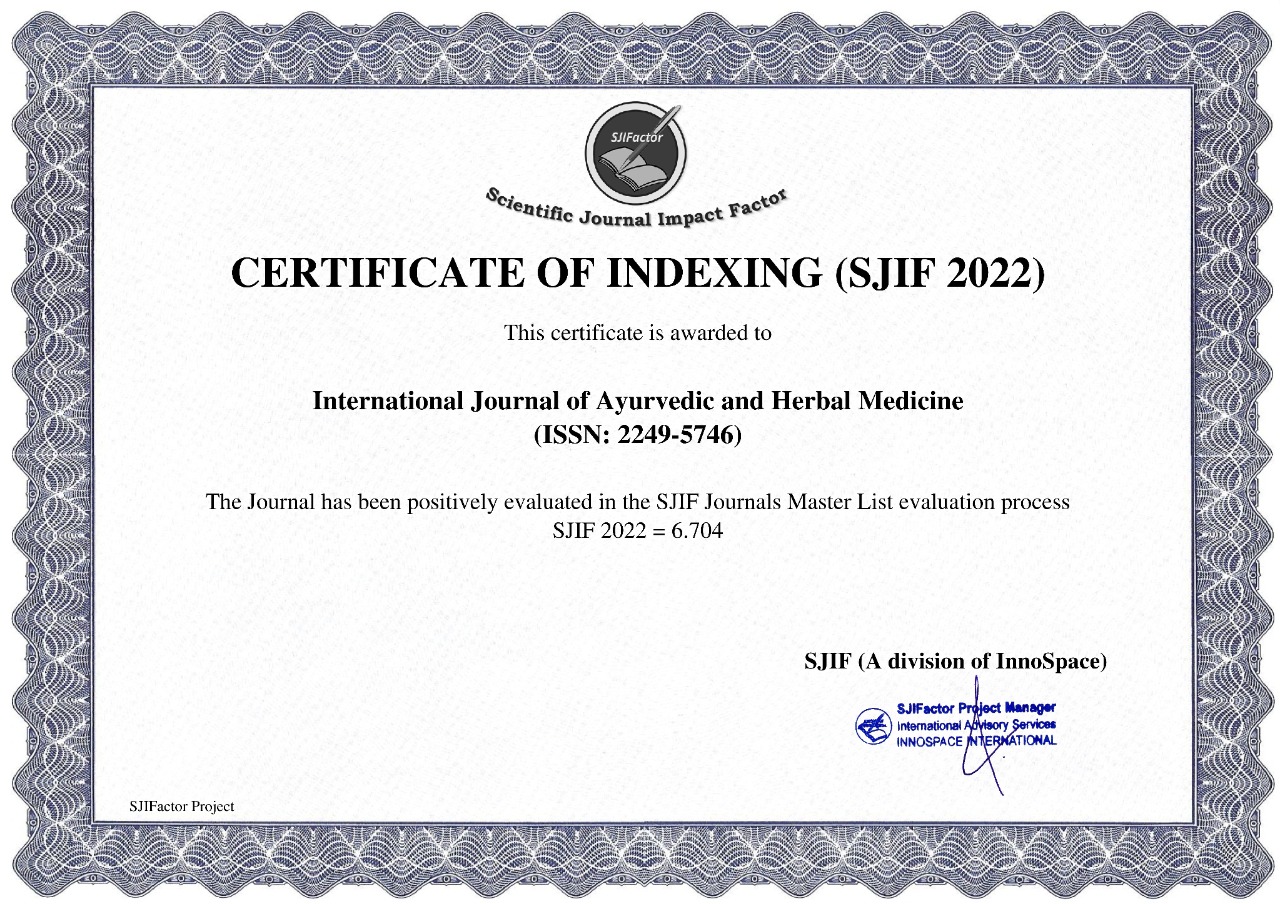


Bhatt T.*, Zaveri Z., Sanghavi U
DOI : http://dx.doi.org/10.47191/ijahm/v13i2.05
Abstract:
Polycystic ovarian syndrome [PCOS] is a hormonal disorder causing enlarged ovaries with small cysts on the outer edges. Between 5% and 10% of women between 15 and 44, or during the years you can have children, have PCOS. Most women find out they have PCOS in their 20s and 30s, when they have problems getting pregnant and see their doctor. But PCOS can happen at any age after puberty. Causes : The cause of polycystic ovary syndrome isn’t well understood, but may involve a combination of genetic and environmental factors. Symptoms: The symptoms of PCOS are trouble conceiving or infertility, mood changes, acne, fatigue, insulin resistance, high testosterone levels, male pattern baldness thinning hair, irregular or missed periods, low sex drive, ovarian cysts, weight changes and trouble losing weight, excessive body hair growth, etc. Diagnosis: PCOS can be diagnosed by androgen excess, ovulatory dysfunction, thyroid dysfunction, hyperandrogenism, hyperandrogenemia, menstrual cycle irregularity, ovarian dysmorphology. Treatment : The treatment of PCOS can be done by healthy eating, exercising and losing weight, blood sugar controlling, reducing stress and anxiety, anti - inflammatory treatment, eliminating toxins, taking vitamins, etc. Pathophysiology: The complex Pathophysiology of PCOS involves the interaction of genetic and epigenetic changes, primary ovarian abnormalities, neuroendocrine alterations, and endocrine and metabolic modifiers such as anti-Mullerian hormone, hyperinsulinemia, insulin resistance, adiposity, and adiponectin levels. There are several herbal formulations which help in reducing cysts formed due to PCOS.
REERENCES:
Aziz R., Woods S.K., Renya R., et al. The Prevalence and Features of the Polycystic Ovary Syndrome in an Unselected Population. JCEM,2004; 89(6): 2745-2749.
- Ferriman D., Gallwey D.J., Clinical Assessment of Body Hair Growth in Women, JCEM,1961; 21(11): 1440-1447.
- Hart R., Franks S., Definitions, Prevalence and Symptoms of Polycystic Ovaries and Polycystic Ovary Syndrome. JCEM,2004; 18(5): 671-683
- Ibanez L., Ferrer A., et al. Insulin Sensitization Early After Menarche Prevents Progression from Precocious Pubarche to Polycystic ovary Syndrome. The Journal of Pediatrics,2004; 144(1): 23-29
- Hickey M., Doherty DA., et al. Clinical Ultrasound and Biochemical features of Polycystic ovary Syndrome in Adolescents: implications for Diagnosis. Human Reproduction,2011; 26(6): 1469-1477
- Hart R., Norman R., Polycystic ovarian syndrome-prognosis and outcomes. Best practice and research clinical obstetrics and gynaecology,2006; 20(5): 751-778
- Balen A., Rajkowha M., Polycystic ovary syndrome-A systemic disorder? Best practice and research clinical obstetrics and gynaecology,2003; 17(2): 263-274
- Wild RA., Long term health consequnces of PCOS. Human reproduction update,2002; 8: 231-241
- Rotterdam ESHRE/ASRM-Sponsored PCOS consensus workshop group., Revised 2003 consensus on diagnostic criteria and long-term health risks related to polycystic ovary syndrome (PCOS). NIH,2004; 19(1): 41-47
- Rotterdam ESHRE/ASRM-Sponsored PCOS consensus workshop group., Revised 2003 consensus on diagnostic criteria and long-term health risks related to polycystic ovary syndrome (PCOS). NIH,2004; 81(1): 19-25
- Azziz R., PCOS: A diagnostic challenge, NIH,2004; 8(6): 644-648
- Deng Y., Zhou H., et al. Effect of Diane-35 on polycystic ovarian syndrome of Different Subtypes. Open Journal of obstetrics and Gynecology,2014; 4(11): 377-384
- Bozdag G., Yapici Z., et al. Prevalence, phenotype and cardio metabolic risk of polycystic ovary syndrome under different diagnostic criteria. Human reproduction,2012; 27(10): 3067-3073
- Agrawal R., Sharma S., et al. Prevalence of polycystic ovaries and polycystic ovary syndrome in lesbian women compared with heterosexual women. Fertility and Sterility,2004; 82(5): 1352-1357
- Ehrmann DA., Barnes RB., et al. Prevalence of impaired glucose tolerance and diabetes in women with polycystic ovary syndrome. Diabetes Care,1999; 22(1): 141-146
- Norman RJ., Masters L., et al. Relative risk of conversion from norm glycaemia to impaired glucose tolerance or non-insulin dependent diabetes mellitus in polycystic ovarian syndrome. Human Reproduction,2001; 16(9): 1995-1998
- Troisi R., Potischman N., et al. Maternal serum oestrogen and androgen concentrations in preeclamptic and uncomplicated pregnancies. International Journal of Epidemiology,2003; 32(3): 455-460
- Eilting MW., Korsen TJM., et al. Prevalence of diabetes mellitus, hypertension and cardiac complaints in a follow-up study of a Dutch PCOS population. Human Reproduction,2001; 16(3): 556-560
- Cussons AJ., Watts GA., et al. cardiovascular disease in the polycystic ovary syndrome: new insights and perspectives. Atherosclerosis,2006; 185(2): 227-239
- Teede HJ., Hutchison S., et al. Insulin resistance, the metabolic syndrome, diabetes, and cardiovascular disease risk in women with PCOS. Endocrine, Stepto Nk., Cassar S., et al. Women with polycystic ovary syndrome have intrinsic insulin resistance on euglycemic–hyperinsulaemic clamp. Human Reproduction,2013; 28(3): 777-784
- Meyer C., McGrath BP., et al. Effects of Medical Therapy on Insulin Resistance and the Cardiovascular System in Polycystic Ovary Syndrome. Diabetes Care,2007; 30(3): 471-478
- Moran LJ., Misso ML., et al. Impaired glucose tolerance, type 2 diabetes and metabolic syndrome in polycystic ovary syndrome: a systematic review and meta-analysis. Human Reproduction Update,2010; 16(4): 347-363
- Fauser BC., Tarlatzis BC., et al. Consensus on women’s health aspects of polycystic ovary syndrome (PCOS): the Amsterdam ESHRE/ASRM-Sponsored 3rd PCOS Consensus Workshop Group. Fertility and Sterility,2012; 97(1): 28-38
- Veltman-Verhulst SM., Boivin J., et al. Emotional distress is a common risk in women with polycystic ovary syndrome: a systematic review and meta-analysis of 28 studies. Human Reproduction Update,2012; 18(6): 638-651
- Jedel E., Waern M., et al. Anxiety and depression symptoms in women with polycystic ovary syndrome compared with controls matched for body mass index. Human Reproduction,2010; 25(2): 450-456
- Mansson M., Holte J., et al. Women with polycystic ovary syndrome are often depressed or anxious—A case control study. Psychoneuroendocrinology,2008; 33(8): 1132-1138
- Rotterdam ESHRE/ASRM-Sponsored PCOS consensus workshop group. Revised 2003 consensus on diagnostic criteria and long-term health risks related to polycystic ovary syndrome. 2004; 81(1): 19-25
- Azziz R., Carmina E., et al. Criteria for Defining Polycystic Ovary Syndrome as a Predominantly Hyperandrogenic Syndrome: An Androgen Excess Society Guideline. JCEM,2006; 91(11): 4237-4245
- Escobar-Morreale HF., Sancho J., et al. The Polycystic Ovary Syndrome Associated with Morbid Obesity May Resolve after Weight Loss Induced by Bariatric Surgery. JCEM,2005; 90(12): 6364-6369
- Longcope C., Adrenal and gonadal androgen secretion in normal females. 1986; 15(2): 213-228
- Pasquali R., Casimirri F., The impact of obesity on hyperandrogenism and polycystic ovary syndrome in premenopausal women. Clinical Endocrinology,1993; 39(1): 1-16
- Rosner W., Auchus R., et al. Utility, Limitations, and Pitfalls in Measuring Testosterone: An Endocrine Society Position Statement. JCEM,2007; 92(2,1): 405-413
- Piltonen T., Koivunen R., et al. Ovarian and adrenal steroid production: regulatory role of LH/HCG. Human Reproduction,2002; 17(3): 620-624
- Lasley BL., Santoro N., et al. The Relationship of Circulating Dehydroepiandrosterone, Testosterone, and Estradiol to Stages of the Menopausal Transition and Ethnicity. JCEM,2002; 87(8,1): 3760-3767
- Piltonen T., Koivunen R., et al. Ovarian Age-Related Responsiveness to Human Chorionic Gonadotropin. JCEM,2003; 88(7,1): 3327-3332
- Giallauria F., Palomba S., et al. Abnormal heart rate recovery after maximal cardiopulmonary exercise stress testing in young overweight women with polycystic ovary syndrome. Clinical Endocrinology,2008; 68(1): 88-93
- Tekin G., Tekin A., et al. Altered autonomic neural control of the cardiovascular system in patients with polycystic ovary syndrome. International of Journal of Cardiology,2008; 130(1): 49-55
- Yildirir A., Aybar F., et al. Heart Rate Variability in Young Women with Polycystic Ovary Syndrome. Annals of non-invasive Electrocardiology,2023; 28(1): 306-312
- Sverrisdottir YB., Mogren T., et al. Is polycystic ovary syndrome associated with high sympathetic nerve activity and size at birth? Am J Physiol Endocrinol Metab,2008; 294(3): 76-81
- Graf MJ., Richards CJ., et al. THE INDEPENDENT EFFECTS OF HYPERANDROGENAEMIA, HYPERINSULINAEMIA, AND OBESITY ON LIPID AND LIPOPROTEIN PROFILES IN WOMEN. Clinical Endocrinology,1990; 33(1): 119-131
- Hoeger k., Davdison K., et al. The Impact of Metformin, Oral Contraceptives, and Lifestyle Modification on Polycystic Ovary Syndrome in Obese Adolescent Women in Two Randomized, Placebo-Controlled Clinical Trials. JCEM,2008; 93(11): 4299-4306
- R Rotterdam ESHRE/ASRM-Sponsored PCOS consensus workshop group. Revised 2003 consensus on diagnostic criteria and long-term health risks related to polycystic ovary syndrome (PCOS). Human reproduction,2004; 19(1): 41-47
- Adams J., Polson DW., Franks S., Prevalence of polycystic ovaries in women with anovulation and idiopathic hirsutism. Br Med J (Clin Res Ed),1986; 293(6543): 355-359
- Franks S., Gharani N., et al. The genetic basis of polycystic ovary syndrome. Human Reproduction,1997; 12(12): 2641-2648
- Franks S., McCarthy M., Genetics of ovarian disorders: polycystic ovary syndrome. Rev Endocr Metab Disord,2004; 5(1): 69-76
- Vink JM., Sadrzadeh S., et al. Heritability of polycystic ovary syndrome in a Dutch twin-family study. JCEM,2006; 91(6): 2100-2104
- Dunaif A., Finegood DT., Beta-cell dysfunction independent of obesity and glucose intolerance in the polycystic ovary syndrome. JCEM,1996; 81(3): 942-947
- Corbould A., Kim YB., et al. Insulin resistance in the skeletal muscle of women with PCOS involves intrinsic and acquired defects in insulin signaling. Am J Physiol Endocrinol Metab, 2005; 288(5): 1047-1054
- Svendsen PF., Nilas L., et al. Obesity, body composition and metabolic disturbances in polycystic ovary syndrome. Hum Reprod,2008; 23(9): 2113-2121
- Graham H., Francis B., et al. Socioeconomic lifecourse influences on women's smoking status in early adulthood. Journal of Epidemiology and Community Health,2006; 60(3): 228-233
- Barkley GS., Factors influencing health behaviors in the National Health and Nutritional Examination Survey, III (NHANES III). Soc Work Health Care,2008; 46(4): 57-79
- Thurston RC., Kubzansky LD., et al. Is the association between socioeconomic position and coronary heart disease stronger in women than in men? Am J Epidemiol,2005; 162(1): 57-65
- Martorell R., Khan Lk., Grummer-strawn LM., Obesity in women from developing countries. Eur J Clin Nutr,2000, 54(3): 247-252
- Kumar apeli V., Seneviratne R de A., et al. A simple screening approach for assessing community prevalence and phenotype of polycystic ovary syndrome in a semi-urban population in Sri Lanka. Am J Epidemiol,2008; 168(3): 321-328
- Rebar RW., Legro RS., et al. Consensus on women's health aspects of polycystic ovary syndrome (PCOS): the Amsterdam ESHRE/ASRM-Sponsored 3rd PCOS Consensus Workshop Group.Fertil Steril,2012; 97(1): 28-38
- BalenA H., Conway GS., et al. Polycystic ovary syndrome: the spectrum of the disorder in 1741 patients. Hum Reprod,1995; 10(8): 2107-2111
- Ridker PM., Buring JE., et al. C-reactive protein, the metabolic syndrome, and risk of incident cardiovascular events: an 8-year follow-up of 14 719 initially healthy American women. Circulation,2003; 107(3): 391-39
- Wehr E., Pilz S., Kopera D., Association of hypovitaminosis D with metabolic disturbances in polycystic ovary syndrome.Eur J Endocrinol,2009; 61(4): 575-582
- Porte D., Central Regulation of Energy Homeostasis: The Key Role of Insulin. Daibetes,2006; 55(2): 8155-8160
- Azziz R., Carmina E., et al. Positions statement: criteria for defining polycystic ovary syndrome as a predominantly hyperandrogenic syndrome: an Androgen Excess Society guideline. JCEM,2006; 91(11): 4237-4245
- Yarak S., Bagatin E., et al. Hyperandrogenism and skin: polycystic ovary syndrome and peripheral insulin resistance. An Bras Dermatol,2005; 80(4): 395-410
- Yarak S., Bagatin E., et al. Hyperandrogenism and skin: polycystic ovary syndrome and peripheral insulin resistance. An Bras Dermatol,2005; 80(4): 395-410
- Buccola JM., Reynolds EE., Polycystic ovary syndrome: a review for primary providers. Primary care: Clinics in office practice,2003; 30(4): 697-710
- Spinasanta S., Its time rename polycystic ovary syndrome. Endocrine Web for Health Care Professionals,2016;
- Nair R., PCOS and it’s ayurvedic treatment.
- Goyal A, Ganie MA, Idiopathic Hyperprolactinemia Presenting as Polycystic Ovary Syndrome in Identical Twin Sisters : A Case Report and Literature Review. NIH,2018 ;10(7) Albu D, Albu A. The relationship between anti-Mullerian hormone serum level and body mass index in a large cohort of infertile patients. NIH, 2019; 63(1) : 157-163 Spinedi E, Cardinali DP. The Polycystic Ovary Syndrome and the Metabolic Syndrome: A Possible Chronobiotic-Cytoprotective Adjuvant Therapy. NIH, 2018.
- Puttabyatappa M, Padmanabhan V. Ovarian and Exta-Ovarian Mediators in the Development of Polycystic Ovary Syndrome. NIH, 2018 ; 61(4): 161-184.
- Polycystic Ovary Syndrome(PCOS): Causes, Signs, and Symptoms , LTA, 2021
- Barbados Family Planning Association
- womenhealth.gov
- womenhealth.gov
- womenhealth.gov
- hopkinsmedicine.org
- Bulsara J., Patel P., Soni A., Acharya S. A review: Brief insight into Polycystic Ovarian Syndrome, Endocrine and Metabolic Science,2021;3
- Knochenhauer E.S., Key T.J., Kahsar-Miller M. et.al. Prevalence of the Polycystic Ovary Syndrome in Unselected Black and White Women of the Southeastern United States: A Prospective Study, JCEM , 1998; 83(9): 3078–3082
- Kandarakis E.V., Chryssa R.K., Bergiele A.T. et.al. A Survey of the Polycystic Ovary Syndrome in the Greek Island of Lesbos: Hormonal and Metabolic Profile. JCEM, 1999; 84(11): 4006–4011
- Asuncion M, Calvo R.M., Millan J.L.et.al. A Prospective Study of the Prevalence of the Polycystic Ovary Syndrome in Unselected Caucasian Women from Spain. JCEM, 2000; 85(7) : 2434–2438
- Taylor A E, Polycystic ovary syndrome.Endocrinol Metab Clin North Am,1998; 27(4): 877-902
- Legro R S ,Polycystic ovary syndrome: current and future treatment paradigms.Am J Obstet Gynecol ,1998; 179(6): 101-108
- Taylor A.E., Mccourt B., Martin K.A. et.al. Determinants of Abnormal Gonadotropin Secretion in Clinically Defined Women with Polycystic Ovary Syndrome. JCEM, 1997; 82(7) : 2248–2256
- Stein I F , Amenorrhea associated with bilateral polycystic ovaries. Am J Obstet Gynecol, 1935 ; 29 : 181-191
- dreamstime.com
- Armanini D., Mattarello M.J., Fiore C., Bonanni G., Licorice reduces serum testosterone in healthy women, PubMed , 2004; 69(11-12) : 736-6
- Grant P., Spearmint Herbal Tea has Significant Anti-androgen Effects in Polycystic Ovarian Syndrome. A Randomized Controlled Trial, PubMed, 2009 ; 24(2) : 186-8
- netmeds.com
- pcosliving.com
- biomedpharmajournal.org
- indianexpress.com
- Kodipalli A., Devi S., Prediction of PCOS and mental health Using Fuzzy Interference and SVM. Front. Public Health, 2021; 9
- Kallen A., Watson S., Polycystic Ovary Syndrome(PCOS): Symptoms, Causes and Treatment. Healthline, 2021
- Neuzil A., What is Polycystic Ovary Syndrome(PCOS). AFM, 2014
- zee5.com : 65 percent women in India unaware of PCOS symptoms; reveals survey conducted by OZiva
- Jain T., Negris O., Brown D. et.al. Characterization of polycystic ovary syndrome among Flo app users around the world. Reproductive Biology and Endocrinology,2021 ; 36
- Kavitha, M. G. Devi, N. PuvaneswariClinical Presentation, Risk Assessment and Management of Polycystic Ovary Syndrome (PCOS). International Journal of Biomedical and Advance Research,2017 ;8 : 66-71
- Robert L. R., David A.E., The Pathogenesis of Polycystic Ovary Syndrome (PCOS): The Hypothesis of PCOS as functional Ovarian Hyperandrogenism Revisited .Endrocrine Society, 2016; 37(5) : 467-520
- Ferreria SR, Motta AB. Uterine Function: From Normal to Polycystic Ovarian Syndrome Alterations.Curr Med Chem. 2018 ; 25(15): 1792-1804
- Gambineri A, Laudisio D, Marocco C, Radellini S, Colao A, Savastano S., Obesity Programs of nutrition, Education, Research and Assessment (OPERA) group. Female infertility: which role for obesity? Int J Obes Suppl., 2019; 9(1): 65-72
- Le Donne M, Alibrandi A Giarrussso R, Lo Monaco I, Muraca U. Diet, metformin and inositol in overweight and obese women with polycystic ovary syndrome: effects on body composition. Bvs , 2012 ; 64(1): 23-9
index






















